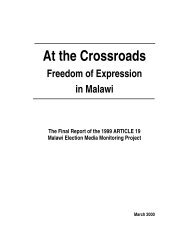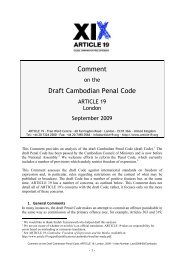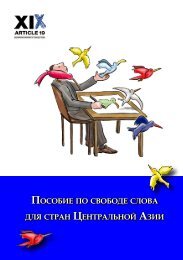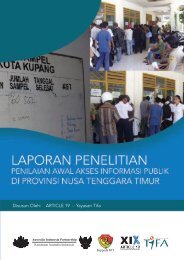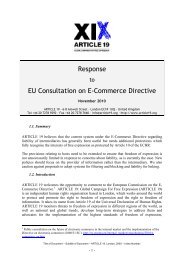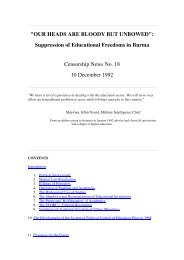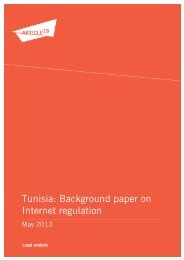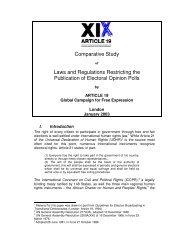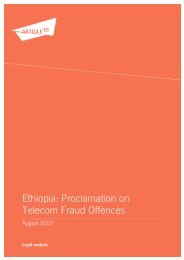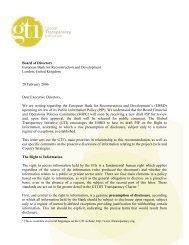FOR INTERNAL USE ONLY - Article 19
FOR INTERNAL USE ONLY - Article 19
FOR INTERNAL USE ONLY - Article 19
- No tags were found...
You also want an ePaper? Increase the reach of your titles
YUMPU automatically turns print PDFs into web optimized ePapers that Google loves.
ARTICLE <strong>19</strong>GLOBAL CAMPAIGN <strong>FOR</strong> FREE EXPRESSION;,& 65" 0 %.In Lviv, NGOs and journalists were extremely concerned about the import and management of toxicwaste from Eastern Europe, particularly from Hungary. 326 The government hid the fact that toxic wastewas disposed of in the Lviv oblast and as a result many people were exposed to health hazards whichthey knew nothing about. 327A substance called Premix, dumped in the town of Bakta between 2001 and 2004, exudespungent fumes that cause severe headaches among the local population. In 2006, a mother of two inBakta said: ‘We are always tired, with headaches and joint pain.’ A scientist at the Institute ofAgriculture, based in Bakta, said: ‘[in the oblast] vegetables are not growing any more, the leaves arefalling from the fruit trees already in the summer … we haven’t seen a mouse in the grain depots ofthe Institute for several years.’Two parents, whose house was only 200 metres from the dumped Premix, said that they couldno longer live there because of the fumes. They added that their children were frequently ill androutinely complained of headaches.;,3 %State secrecy contributed both to causing the explosion (to a lesser degree) and to worsening its effects(to a much greater extent – see Section 2.1). 328 Before the accident, the State’s efforts to keep nuclearissues secret meant that the reactor’s operators did not know that withdrawing control rods could leadto an explosion. They were simply told that this was ‘forbidden’. 329 Despite their frequency, nuclearaccidents in the USSR were kept secret. 330 This meant that the plant’s staff and the general public wereunaware of the hazards posed to society and were not able to respond to the accident adequately.Government attempts to hide the incident, usually referred to as the ‘Chornobyl cover-up’, ledto the mismanagement of the crisis. Immediately after the event, the Kremlin issued ‘top secret’instructions to classify all data on the accident, especially that relating to the health of the affectedpopulation. 331 As a result, rumours and misinformation multiplied. Even influential figures in theUkrainian government did not have information, as decisions were made exclusively in the Kremlin326 See Section 2.4. ARTICLE <strong>19</strong> interview with environmental journalists in Lviv, January 2007.327 Ibid.328 ‘The State and Chernobyl’, New Scientist, 11 November <strong>19</strong>89.329 Ibid.330 In Chelyabinsk and Kyshtym (both in Russia), three nuclear accidents took place between <strong>19</strong>49 and <strong>19</strong>67,contaminating over half a million people.331 A Turevich, ‘Chernobyl – Byelorussian Tragedy’, Byelorussian Review, No.3, <strong>19</strong>89,http://www.geocities.com/CapitolHill/Senate/1447/Belrev1.htm.For Internal Use Only. Is Post-Chornobyl Ukraine Ready for Access to Environmental Information?ARTICLE <strong>19</strong>, London, 2007)*



